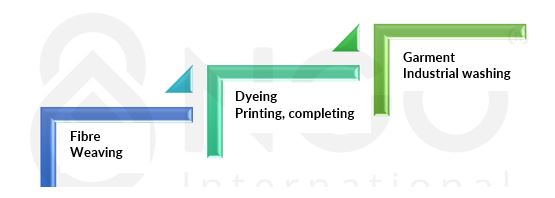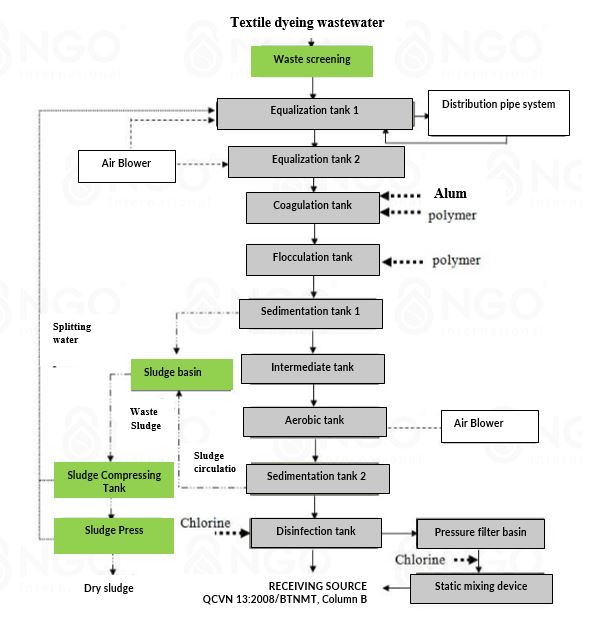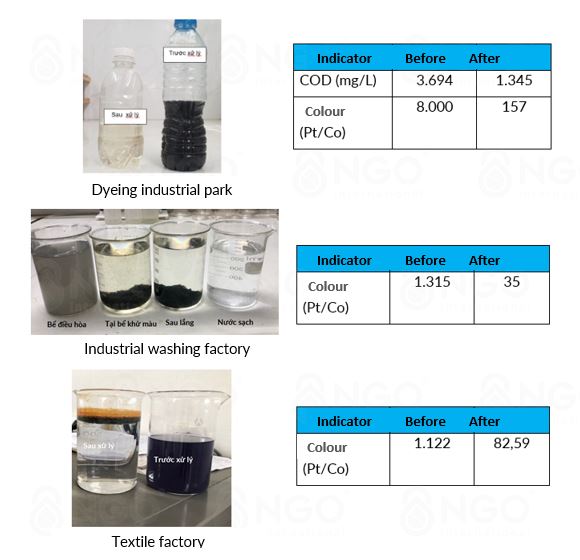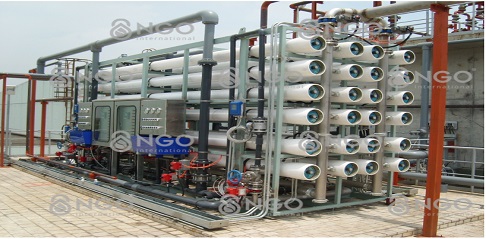A BREAKTHROUGH IN COLOR TREATMENT OF TEXTILE DYEING WASTEWATER & INDUSTRIAL WASHING
SESSIONS OF THE GARMENT AND TEXTILE INDUSTRY
It is estimated that the amount of wastewater discharged from the textile dyeing processes is very large; from 120 to 300m3/ton of fabric, the weaving and dyeing stage requires from 12 to 65 liters of water for 1 meter of fabric and discharges from 10 to 40 liters of water. Textile wastewater is very diverse and complex. According to calculations from the types of chemicals used such as: dyes, surfactants, electrolytes, lozenges, media, starch, enamel, oxidants ...There have been hundreds of typical chemicals such as solutes and heavy metals.
1. Composition and characteristics of textile dyeing wastewater
Wastewater from textile industry includes main pollutants: High temperature, impurities separated from textiles such as grease, nitrogen-containing compounds, pectin, dirt sticking to fibers; chemicals used in technological processes such as starch starch, H2SO4, CH3COOH, NaOH, NaOCl, H2O2, Na2CO3, ... dyes, auxiliaries, soak, colorant, detergent. The amount of chemicals used depends on the type of fabric, color and mainly goes to the wastewater of the manufacturing stage.
1.1 Pollutants and wastewater characteristics of textile and dye industry
|
Stage |
Pollutants in wastewater |
Characteristics of wastewater |
|---|---|---|
|
Sizing and desizing |
Starch, glucozo, carboxymethyl cellulose, polyvinyl alcohol, plastic, fat and wax |
High BOD |
|
Boiling, discoloration |
NaOH, wax and grease, ash, soda, sodium silicate and shredded fibers |
High alkalinity, dark color, high BOD |
|
White bleaching |
Hipoclorite, chlorine compounds, NaOH, AOX, acids, etc |
High alkalinity, accounting for 5% of BOD |
|
Polishing |
NaOH, impurities |
High alkalinity, low BOD |
|
Dyeing |
The main dyes include reconstituted dyes, dispersants, active substances, direct agents, acids, cations, acids and metal salts. |
High color, high BOD (6% of total BOD), high TSS |
|
Printing |
Pigments, starch, oil, clay, metal salts, acids, etc. |
High color, high BOD and grease |
|
Completing |
Starch, animal fat, salt |
Mild alkali, low BOD, small amount |
|
Industrial washing |
Regular washing or Denim washing |
High color, low BOD |
(Source: Wastewater treatment technology using biological methods - Assoc. Prof. PhD. Luong Duc Pham)
1.2 Wastewater characteristics of some dyeing factories in Vietnam
|
Parameter |
Unit |
Woven cotton products |
Knitwear products |
Woolen textiles |
Fiber |
|
Wastewater |
m3/t. of textile |
394 |
264 |
114 |
236 |
|
Ph |
– |
8 – 11 |
9 – 10 |
9 |
9 – 11 |
|
TSS |
mg/l |
400 – 1000 |
950 – 1380 |
420 |
800 – 1300 |
|
BOD5 |
mg/l |
70 – 135 |
90 – 220 |
120 – 130 |
90 – 130 |
|
COD |
mg/l |
150 – 380 |
230 – 500 |
400 – 450 |
210 – 230 |
|
Color |
Pt - Co |
250 – 600 |
250 – 500 |
260 – 300 |
– |
(Source: Faculty of Environment - Hanoi University of Science, 2004)
1.3 The composition of dyeing wastewater is presented in the following table:
|
Indicator |
Unit |
Result |
||
|
Activated substance wastewater |
Sulfur wastewater |
Bleaching wastewater |
||
|
pH |
– |
11-Oct |
>11 |
>12 |
|
COD |
mg/l |
450 – 1.500 |
10.000 – 40.000 |
9.000 – 30.000 |
|
BOD5 |
mg/l |
200 – 800 |
2.000 – 10.000 |
4.000 – 17.000 |
|
Total N |
mg/l |
5 – 15 |
100 – 1.000 |
200 – 1.000 |
|
Total P |
mg/l |
0.7 – 3 |
7 – 30 |
10 – 30 |
|
SS |
mg/l |
– |
– |
– |
|
Color |
Pt-Co |
7.000 – 50.000 |
10.000 – 50.000 |
500 – 2.000 |
|
Turbidity |
FAU |
140 – 1.500 |
8.000 – 200.000 |
1.000 – 5.000 |
(Source: Faculty of Environment - Ho Chi Minh City University of Technology)
Basically, textile-dyeing wastewater often has high temperature, high level of color, pH> 9, high BOD and COD. On the other hand, wastewater from textile industry contains some chemicals with heavy metals, toxic components that not only destroys aquatic organisms but also has negative and direct impact on human life.
Current technology of textile wastewater treatment
2. Wastewater treatment technology of textile and dyeing industry is currently applying common technologies:
• Combination of chemical-physical method (coagulation / flocculation) and filtration;
• Combination of chemical-physical method and aerobic biological treatment or vice versa;
• Combination of chemical-physical method, aerobic biological and chemical-physical treatment;
• Combination of chemical-physical method, biological treatment and filtration (sand filter or activated carbon)
Diagram of the current technological process of textile dyeing wastewater treatment:
In general, the traditional technologies currently applied to the textile wastewater treatment still have many difficulties for businesses, for example:
• Using chemicals mainly can eliminates dispersed colors only, more complex color components such as reactivation and reconstitution are often impossible to be removed.
• When using many chemicals, operating costs will be very high, it is especially difficult to quantify chemicals for flocculation steps, or Fenton due to production by order, color composition and pollution concentration of wastewater often fluctuates according to orders.
• Microbiological systems are often large, requiring a lot of space
NGO with breakthrough solution to color treatment
• Eliminates above 95% of all colors, including activated color, no use of flocculating or decolorizing chemicals, less produced sludge.
• Color treatment efficiency is independent of the microbiology and weather fluctuations
• Results are visible on the first day of operation, without waiting
* Color treatment process is extremely simple: Textile wastewater is firstly collected to the flow equalization basin with aeration, and then pumped onto the Decoloring Device by electrolytic oxidation; at this step, metal ions and electrons are generated, creating redox reactions to break down the emulsion, destroy colloids and suspended solids. Fe ++ or Al ++ ions are released from the electrode, creating stable flocculants to remove most of the color in wastewater by flotation or gravity deposition or mechanical filtration, leaving the clear water be discharged or pumped into the next treatment facility. In particular, the contaminated components including heavy metals, grease and most of the COD are also removed at the same time of color treatment.

3. Practical case studies in Vietnam
Mores: Wastewater treatment of textile and dyeing industry video: https://www.youtube.com/watch
If your business is interested in solution to inlet water treatment, or has a demand for ion exchange materials, please contact NGO via phone number (024) 3566 8225 or email office@8ngo.com for direct consultation.
thong_tin_lien_quan
-
 Wastewater treatment
Wastewater treatment
-
 A standard domestic wastewater
A standard domestic wastewater
-
 B standard domestic wastewater
B standard domestic wastewater
-
 Pig Farm Wastewater
Pig Farm Wastewater
-
 Textile dyeing wastewater
Textile dyeing wastewater
-
 Paper industry wastewater solution
Paper industry wastewater solution
-
 Textile Dyeing Wastewater & Industrial Washing
Textile Dyeing Wastewater & Industrial Washing
-
 Slaughter wastewater treatment solution
Slaughter wastewater treatment solution
-
 Aquaculture wastewater
Aquaculture wastewater
-
 Starch wastewater
Starch wastewater
-
 Petroleum wastewater
Petroleum wastewater
-
 Beer wastewater
Beer wastewater
-
 Other industrial wastewaters
Other industrial wastewaters
-
 BioPM - Organic Industrial wastewater treatment solution
BioPM - Organic Industrial wastewater treatment solution
-
 MBR solutions
MBR solutions
-
 Conventional activated sludge (CAS)
Conventional activated sludge (CAS)
-
 Moving bed biofilm reactor (MBBR)
Moving bed biofilm reactor (MBBR)
-
 Anaerobic- Anoxic-Aerobic (AAO)
Anaerobic- Anoxic-Aerobic (AAO)
-
 Sequencing batch reactor (SBR)
Sequencing batch reactor (SBR)
-
 Physical & Chemical methods
Physical & Chemical methods
-
 Supply water treatment
Supply water treatment
-
 Cooling system water
Cooling system water
-
 Water treatment for food and Beverage production
Water treatment for food and Beverage production
-
 Ultra pure water supply solution for electronic industry
Ultra pure water supply solution for electronic industry
-
 Pure water supply for pharmaceutical manufacturers
Pure water supply for pharmaceutical manufacturers
-
 Water Supply treatment with ion exchange method
Water Supply treatment with ion exchange method
-
 Ordor Treatment
Ordor Treatment





_-_NGO__2_jfif_da_sua.jpg)

